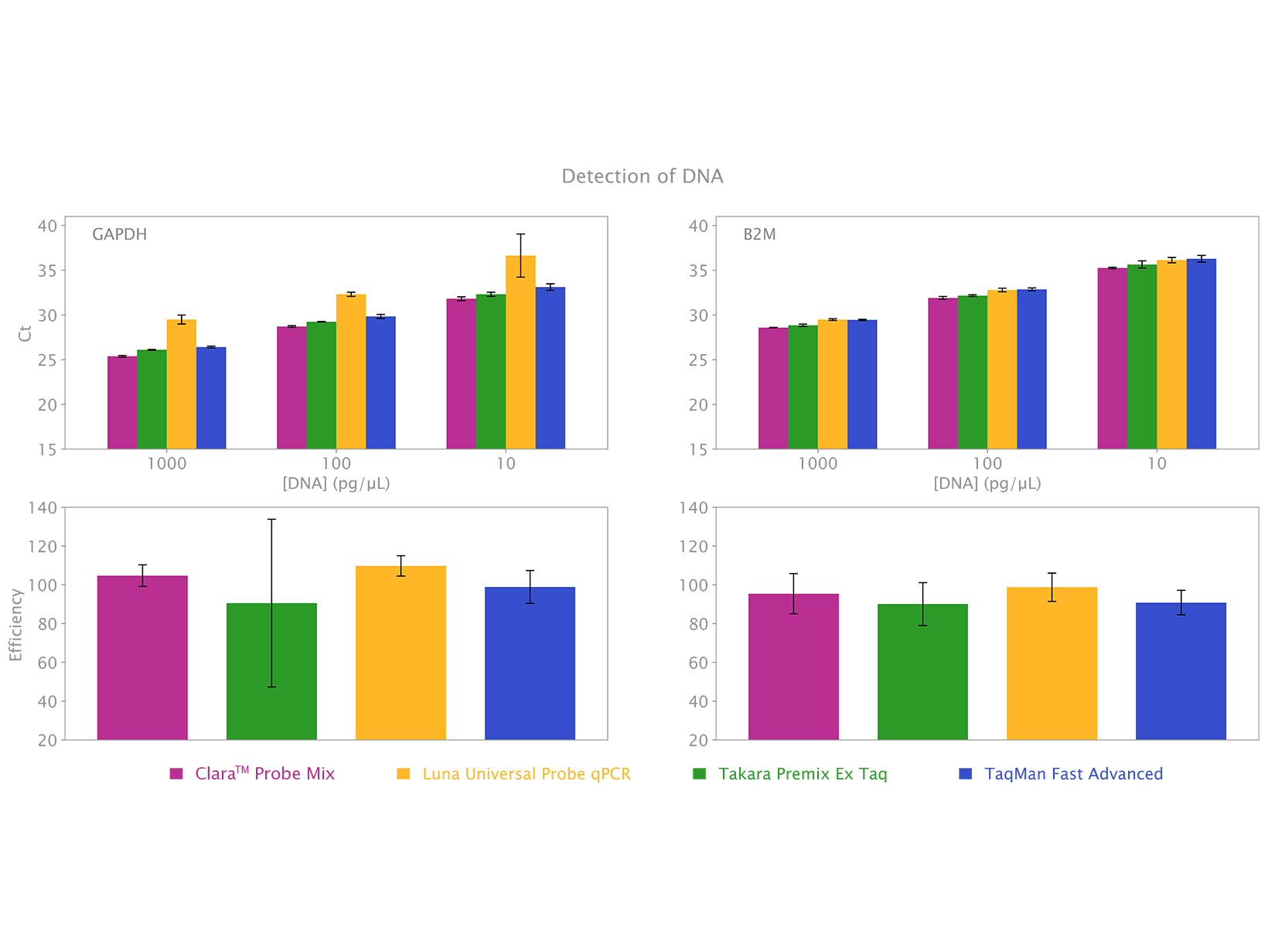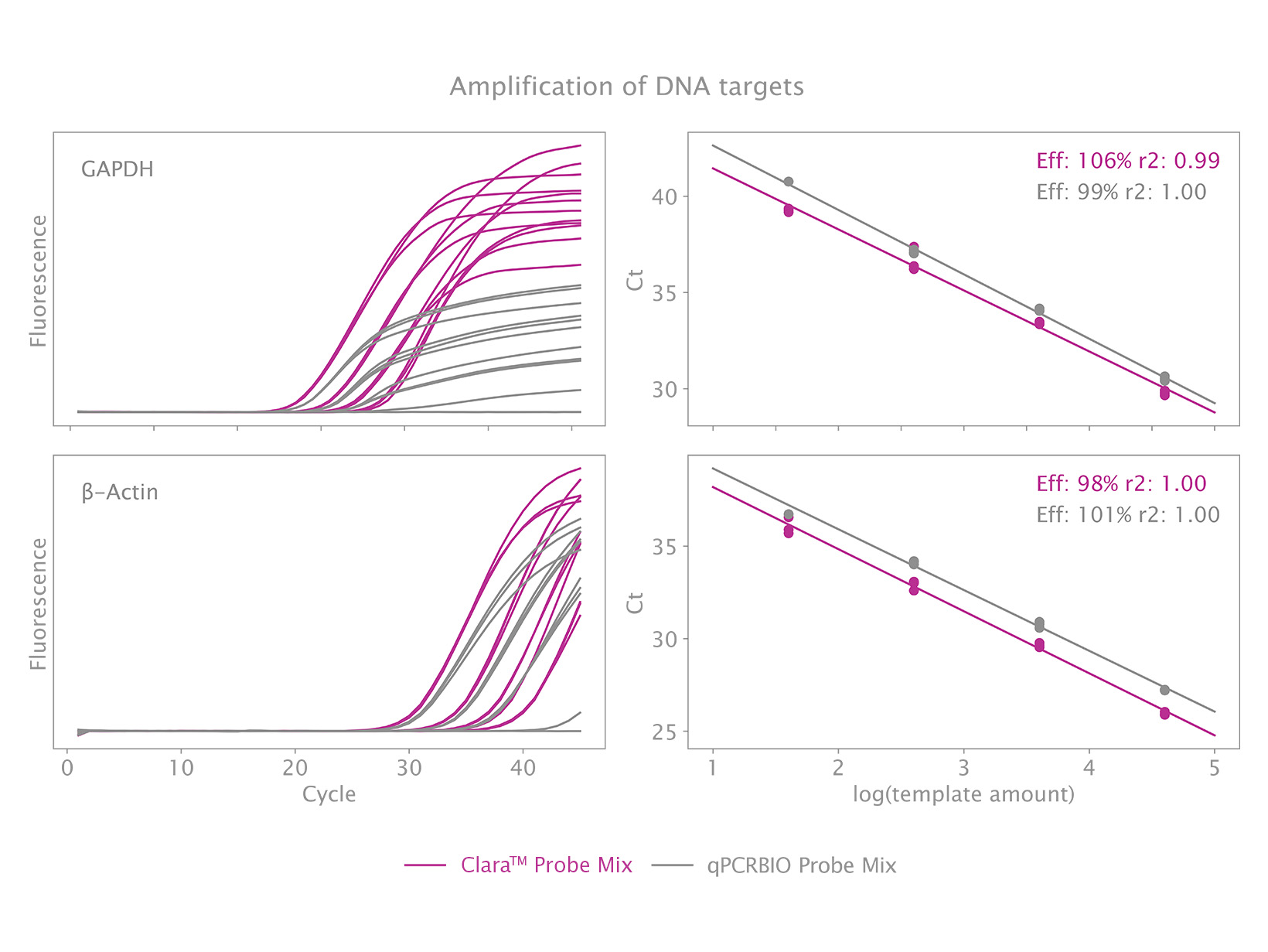To view your price please login or contact us
Clara™ Probe Purple Mix
Get the performance of Clara™ Probe Mix with an easy-to-see, inert, purple dye for sample visualisation. Cutting-edge universal probe-based qPCR detection of DNA targets becomes easier than ever before.
Clara™ Probe Purple Mix offers the same reliable, sensitive and specific performance of our latest probe-based qPCR mixes. Additionally, the mix is supplemented with a unique purple dye for sample visualisation during plate setup. This dye is non-inhibitory to PCR and doesn’t affect commonly used fluorescent probes, with minimal quenching, which ensures strong signal generation for accurate measurements.
Features:
- Concentrated 4x mix format, ideal for high-throughput, highly multiplexed assays
- Superior detection of DNA targets
- Reliable quantification of low copy templates
- Antibody hot start for increased sensitivity and specificity
- Improved speed and sensitivity for early target detection
- Inert purple dye for easy visualisation during set up
More Information
Easy to see purple dye
Clara™ Probe Purple Mix combines the speed, sensitivity and specificity of the Clara™ reagent family with an inert purple dye for easy sample visualisation. The dye has greatly reduced quenching of probe fluorophores, to ensure accurate qPCR results, while reducing handling and pipetting
Decreases in probe fluorescent intensity for in Clara™ Probe Purple Mixes:
FAM: up to 25%
HEX: up to 30%
Tex: up to 25%
Cy5: up to 10%
The percentages represent the plateau height reduction (Purple mix vs basic mix) in at least two different reactions.
Reliable Probe-based qPCR
Clara™ Probe Mix is engineered to enable qPCRs with the highest sensitivity, reliability, and with the greatest ease of use in diagnostic applications and basic research alike. It is a universal qPCR mix suitable for all types of probe technologies, including TaqMan®, Scorpions® and molecular beacons. Powered by our unique hot start Taq DNA polymerase the qPCR mix is suitable for DNA detection for 2-step RT-qPCR protocols when used with a separate cDNA synthesis kit. Although for routine RNA quantification we recommend 1-step protocols with Clara™ Probe 1-Step Mix for a more streamlined workflow.
Clara™ Probe Mix can be used for all types of probe-based qPCR applications, including gene expression analysis, SNP/allele detection, genotyping and allelic discrimination studies, species abundance quantification, and can offers high efficiency in both single and multiplex assays. Making this mix highly versatile and ideal for in-vitro diagnostic kit development as well as basic research.
The mix is also suitable for melt-curve analysis (with hybridisation probes only) and is available without passive reference dye (No-ROX), or with reverence dye as Lo-ROX, Hi-ROX and separate-ROX formulations. Use our qPCR Selection Tool to find out which ROX variant is compatible with your instrument.
Need help with probe based qPCR experimental design?
Be sure to design primers and probes carefully. For efficient amplification under fast cycling conditions we recommend amplicon lengths between 80 bp and 200 bp. With all manufacturers master mixes the shorter the amplicon length the faster the reaction can be cycled. Amplicon lengths should not exceed 400 bp. Primers should have a predicted melting temperature of around 60 °C, using default Primer 3 settings (https://bioinfo.ut.ee/primer3/). For TaqMan® probes choose probe close to 5’ primer, avoid terminal guanosine residues. Ensure ideal probe dye and quencher combinations, especially in multiplexed reactions.
For further information on how to design qPCR experiments and analyse qPCR results, please refer to our technical guide.
Applications
- 2-step RT-qPCR
- Species abundance quantification
- Genotyping
- Allelic discrimination
- In vitro diagnostic kit development
- Single & multiplex DNA detection
Specifications
Clara™ Probe Purple Mix Lo-ROX
Component
200 Reactions
600 Reactions
1000 Reactions
10 000 Reactions
4x Clara™ Probe Purple Mix Lo-ROX
1 x 1 mL
3 x 1 mL
5 x 1 mL
1 x 50 mL
Clara™ Probe Purple Mix Hi-ROX
Component
200 Reactions
600 Reactions
1000 Reactions
10 000 Reactions
4x Clara™ Probe Purple Mix Hi-ROX
1 x 1 mL
3 x 1 mL
5 x 1 mL
1 x 50 mL
Clara™ Probe Purple Mix No-ROX
Component
200 Reactions
600 Reactions
1000 Reactions
10 000 Reactions
4x Clara™ Probe Purple Mix No-ROX
1 x 1 mL
3 x 1 mL
5 x 1 mL
1 x 50 mL
Clara™ Probe Purple Mix Separate-ROX
Component
200 Reactions
600 Reactions
1000 Reactions
4x Clara™ Probe Purple Mix No-ROX
1 x 1 mL
3 x 1 mL
5 x 1 mL
50 μΜ ROX Additive
1 x 200 μL
1 x 200 μL
1 x 200 μL
Clara™ Probe Purple Mix Lo-ROX
Component
4x Clara™ Probe Purple Mix Lo-ROX
200 Reactions
1 x 1 mL
600 Reactions
3 x 1 mL
1000 Reactions
5 x 1 mL
10 000 Reactions
1 x 50 mL
Clara™ Probe Purple Mix Hi-ROX
Component
4x Clara™ Probe Purple Mix Hi-ROX
200 Reactions
1 x 1 mL
600 Reactions
3 x 1 mL
1000 Reactions
5 x 1 mL
10 000 Reactions
1 x 50 mL
Clara™ Probe Purple Mix No-ROX
Component
4x Clara™ Probe Purple Mix No-ROX
200 Reactions
1 x 1 mL
600 Reactions
3 x 1 mL
1000 Reactions
5 x 1 mL
10 000 Reactions
1 x 50 mL
Clara™ Probe Purple Mix Separate-ROX
Component
4x Clara™ Probe Purple Mix No-ROX
50 μΜ ROX Additive
200 Reactions
1 x 1 mL
1 x 200 μL
600 Reactions
3 x 1 mL
1 x 200 μL
1000 Reactions
5 x 1 mL
1 x 200 μL
Reaction Volume
Storage
20 μL
On arrival, products should be stored between -30 and -15°C. If stored correctly the kit will retain full activity for 12 months.
Reaction Volume
20 μL
Storage
On arrival, products should be stored between -30 and -15°C. If stored correctly the kit will retain full activity for 12 months.
Instrument Compatibility
This product is compatible with all standard and fast cycling qPCR instruments. Use our qPCR Selection Tool to find out which ROX variant is compatible with your instrument.
Documents
Product Flyers
Product Manuals
Material Safety Data Sheets
Certificate of Analysis Finder
FAQs
Can products generated with Clara™ and Clara™ Purple mixes be digested, cloned, and sequenced?
Yes, PCR products generated with these mixes have the same characteristics as PCR products generated with wild-type Taq polymerase. They may be sequenced or digested with restriction endonucleases using standard protocols. Products are 3′-d(A)-tailed and may be used for TA cloning or may be blunt-ended or digested with restriction enzymes prior to cloning. For best results, we recommend purifying the PCR products using any standard PCR clean-up kit.
Do Clara™ Probe Mix and Clara™ Probe 1-Step Mix contain the FAM dye in it?
No. Apart from ROX (if present in the kit), there is no other dye in our mixes. You can therefore use any fluorophore-conjugated probe for your reaction.
Is it normal if the fluorescence of Clara™ Probe Mix and Clara™ Probe 1-Step Mix differs from the one obtained with competitors’ products?
Different products could give a different plateau of fluorescence. However, this has no impact on quantification accuracy and Ct values will not differ among products.
Is the storage of sample DNA in 1x TE (10 mM Tris-HCl / 1 mM EDTA) buffer compatible with subsequent qPCR using Clara™ Probe Mix and Clara™ Probe 1-Step Mix?
Yes, this storage buffer is compatible. The EDTA will chelate some of the magnesium in the mix, but not significantly enough to affect the reaction.
What are the ROX concentrations in Clara™ Probe Mix, Clara™ Probe 1-Step Mix and corresponding purple mixes?
The Clara™ Probe Purple and Clara™ Probe 1-Step Purple Mixes that contain passive reference dyes come in different formulations, each with a different concentration of the passive reference dye:
Lo-ROX mixes (PB20.65 and PB25.85) contain 200 nM ROX.
Hi-ROX mixes (PB20.66 and PB25.86) contain 2 µM ROX.
No-ROX mixes (PB20.67 and PB25.87) do not contain ROX.
Separate-ROX mixes (PB20.68 and PB25.88) include a separate tube of 50 µM ROX additive. This enables you to choose what concentration of ROX you’d like to use.
You can use our qPCR Selection Tool under the Resources drop-down menu to determine which of our mixes are best suited for your qPCR machine.
What troubleshooting is recommended if there are non-specific products in my qPCR?
There are different options to consider when optimising the reaction:
Reduce the annealing/extension time to 5 seconds
Increase the annealing/extension temperature from 60 to 65°C
Dilute the DNA template by starting with 5ng of DNA and using a 10x template dilution series. In addition to running these on a gel to see if the non-specific products persist, the efficiency of the reaction can be calculated with the software of the qPCR instrument after doing the template dilution. If the efficiency is between 90 – 110%, then the amplicon is being doubled every cycle.
More Information
Easy to see purple dye
Clara™ Probe Purple Mix combines the speed, sensitivity and specificity of the Clara™ reagent family with an inert purple dye for easy sample visualisation. The dye has greatly reduced quenching of probe fluorophores, to ensure accurate qPCR results, while reducing handling and pipetting
Decreases in probe fluorescent intensity for in Clara™ Probe Purple Mixes:
FAM: up to 25%
HEX: up to 30%
Tex: up to 25%
Cy5: up to 10%
The percentages represent the plateau height reduction (Purple mix vs basic mix) in at least two different reactions.
Reliable Probe-based qPCR
Clara™ Probe Mix is engineered to enable qPCRs with the highest sensitivity, reliability, and with the greatest ease of use in diagnostic applications and basic research alike. It is a universal qPCR mix suitable for all types of probe technologies, including TaqMan®, Scorpions® and molecular beacons. Powered by our unique hot start Taq DNA polymerase the qPCR mix is suitable for DNA detection for 2-step RT-qPCR protocols when used with a separate cDNA synthesis kit. Although for routine RNA quantification we recommend 1-step protocols with Clara™ Probe 1-Step Mix for a more streamlined workflow.
Clara™ Probe Mix can be used for all types of probe-based qPCR applications, including gene expression analysis, SNP/allele detection, genotyping and allelic discrimination studies, species abundance quantification, and can offers high efficiency in both single and multiplex assays. Making this mix highly versatile and ideal for in-vitro diagnostic kit development as well as basic research.
The mix is also suitable for melt-curve analysis (with hybridisation probes only) and is available without passive reference dye (No-ROX), or with reverence dye as Lo-ROX, Hi-ROX and separate-ROX formulations. Use our qPCR Selection Tool to find out which ROX variant is compatible with your instrument.
Need help with probe based qPCR experimental design?
Be sure to design primers and probes carefully. For efficient amplification under fast cycling conditions we recommend amplicon lengths between 80 bp and 200 bp. With all manufacturers master mixes the shorter the amplicon length the faster the reaction can be cycled. Amplicon lengths should not exceed 400 bp. Primers should have a predicted melting temperature of around 60 °C, using default Primer 3 settings (https://bioinfo.ut.ee/primer3/). For TaqMan® probes choose probe close to 5’ primer, avoid terminal guanosine residues. Ensure ideal probe dye and quencher combinations, especially in multiplexed reactions.
For further information on how to design qPCR experiments and analyse qPCR results, please refer to our technical guide.
Applications
- 2-step RT-qPCR
- Species abundance quantification
- Genotyping
- Allelic discrimination
- In vitro diagnostic kit development
- Single & multiplex DNA detection
Specifications
Clara™ Probe Purple Mix Lo-ROX
Component
200 Reactions
600 Reactions
1000 Reactions
10 000 Reactions
4x Clara™ Probe Purple Mix Lo-ROX
1 x 1 mL
3 x 1 mL
5 x 1 mL
1 x 50 mL
Clara™ Probe Purple Mix Hi-ROX
Component
200 Reactions
600 Reactions
1000 Reactions
10 000 Reactions
4x Clara™ Probe Purple Mix Hi-ROX
1 x 1 mL
3 x 1 mL
5 x 1 mL
1 x 50 mL
Clara™ Probe Purple Mix No-ROX
Component
200 Reactions
600 Reactions
1000 Reactions
10 000 Reactions
4x Clara™ Probe Purple Mix No-ROX
1 x 1 mL
3 x 1 mL
5 x 1 mL
1 x 50 mL
Clara™ Probe Purple Mix Separate-ROX
Component
200 Reactions
600 Reactions
1000 Reactions
4x Clara™ Probe Purple Mix No-ROX
1 x 1 mL
3 x 1 mL
5 x 1 mL
50 μΜ ROX Additive
1 x 200 μL
1 x 200 μL
1 x 200 μL
Clara™ Probe Purple Mix Lo-ROX
Component
4x Clara™ Probe Purple Mix Lo-ROX
200 Reactions
1 x 1 mL
600 Reactions
3 x 1 mL
1000 Reactions
5 x 1 mL
10 000 Reactions
1 x 50 mL
Clara™ Probe Purple Mix Hi-ROX
Component
4x Clara™ Probe Purple Mix Hi-ROX
200 Reactions
1 x 1 mL
600 Reactions
3 x 1 mL
1000 Reactions
5 x 1 mL
10 000 Reactions
1 x 50 mL
Clara™ Probe Purple Mix No-ROX
Component
4x Clara™ Probe Purple Mix No-ROX
200 Reactions
1 x 1 mL
600 Reactions
3 x 1 mL
1000 Reactions
5 x 1 mL
10 000 Reactions
1 x 50 mL
Clara™ Probe Purple Mix Separate-ROX
Component
4x Clara™ Probe Purple Mix No-ROX
50 μΜ ROX Additive
200 Reactions
1 x 1 mL
1 x 200 μL
600 Reactions
3 x 1 mL
1 x 200 μL
1000 Reactions
5 x 1 mL
1 x 200 μL
Reaction Volume
Storage
20 μL
On arrival, products should be stored between -30 and -15°C. If stored correctly the kit will retain full activity for 12 months.
Reaction Volume
20 μL
Storage
On arrival, products should be stored between -30 and -15°C. If stored correctly the kit will retain full activity for 12 months.
Instrument Compatibility
This product is compatible with all standard and fast cycling qPCR instruments. Use our qPCR Selection Tool to find out which ROX variant is compatible with your instrument.
Documents
Product Flyers
Product Manuals
Material Safety Data Sheets
Certificate of Analysis Finder
FAQs
Can products generated with Clara™ and Clara™ Purple mixes be digested, cloned, and sequenced?
Yes, PCR products generated with these mixes have the same characteristics as PCR products generated with wild-type Taq polymerase. They may be sequenced or digested with restriction endonucleases using standard protocols. Products are 3′-d(A)-tailed and may be used for TA cloning or may be blunt-ended or digested with restriction enzymes prior to cloning. For best results, we recommend purifying the PCR products using any standard PCR clean-up kit.
Do Clara™ Probe Mix and Clara™ Probe 1-Step Mix contain the FAM dye in it?
No. Apart from ROX (if present in the kit), there is no other dye in our mixes. You can therefore use any fluorophore-conjugated probe for your reaction.
Is it normal if the fluorescence of Clara™ Probe Mix and Clara™ Probe 1-Step Mix differs from the one obtained with competitors’ products?
Different products could give a different plateau of fluorescence. However, this has no impact on quantification accuracy and Ct values will not differ among products.
Is the storage of sample DNA in 1x TE (10 mM Tris-HCl / 1 mM EDTA) buffer compatible with subsequent qPCR using Clara™ Probe Mix and Clara™ Probe 1-Step Mix?
Yes, this storage buffer is compatible. The EDTA will chelate some of the magnesium in the mix, but not significantly enough to affect the reaction.
What are the ROX concentrations in Clara™ Probe Mix, Clara™ Probe 1-Step Mix and corresponding purple mixes?
The Clara™ Probe Purple and Clara™ Probe 1-Step Purple Mixes that contain passive reference dyes come in different formulations, each with a different concentration of the passive reference dye:
Lo-ROX mixes (PB20.65 and PB25.85) contain 200 nM ROX.
Hi-ROX mixes (PB20.66 and PB25.86) contain 2 µM ROX.
No-ROX mixes (PB20.67 and PB25.87) do not contain ROX.
Separate-ROX mixes (PB20.68 and PB25.88) include a separate tube of 50 µM ROX additive. This enables you to choose what concentration of ROX you’d like to use.
You can use our qPCR Selection Tool under the Resources drop-down menu to determine which of our mixes are best suited for your qPCR machine.
What troubleshooting is recommended if there are non-specific products in my qPCR?
There are different options to consider when optimising the reaction:
Reduce the annealing/extension time to 5 seconds
Increase the annealing/extension temperature from 60 to 65°C
Dilute the DNA template by starting with 5ng of DNA and using a 10x template dilution series. In addition to running these on a gel to see if the non-specific products persist, the efficiency of the reaction can be calculated with the software of the qPCR instrument after doing the template dilution. If the efficiency is between 90 – 110%, then the amplicon is being doubled every cycle.










